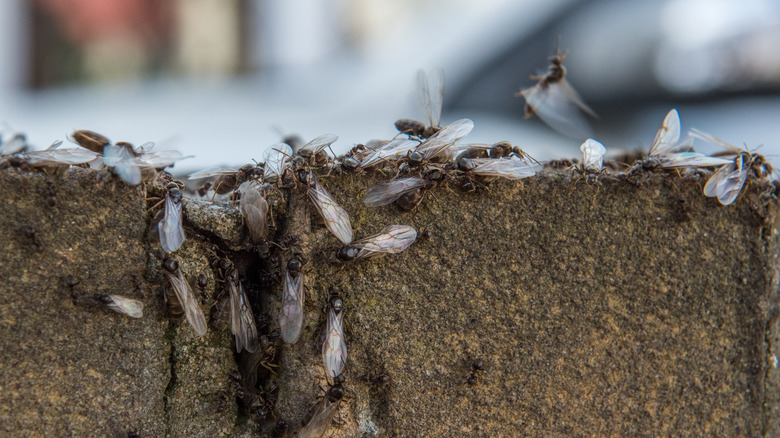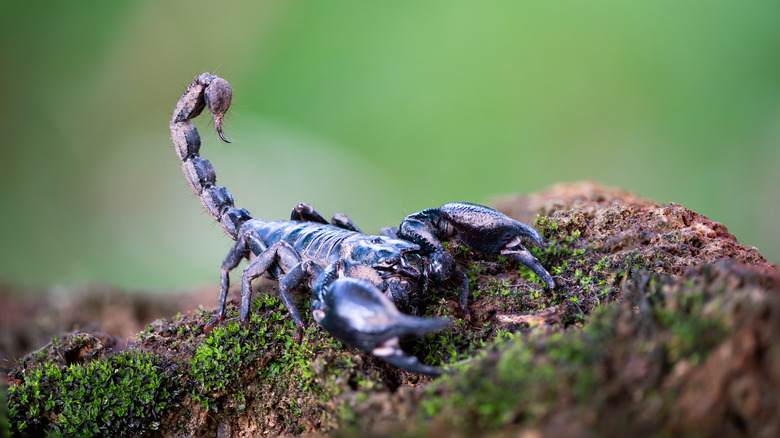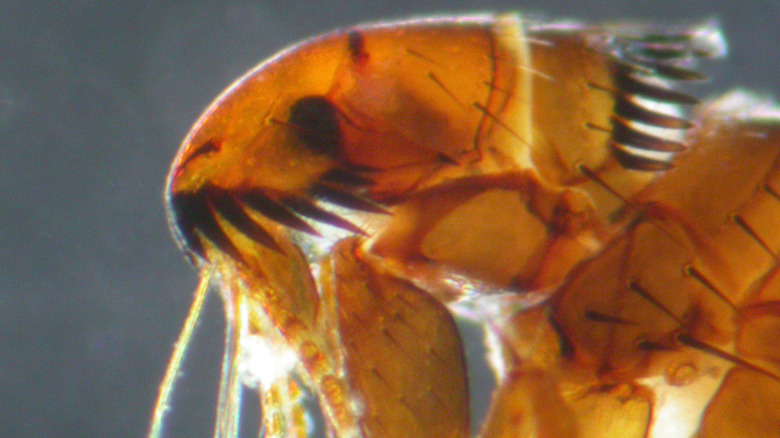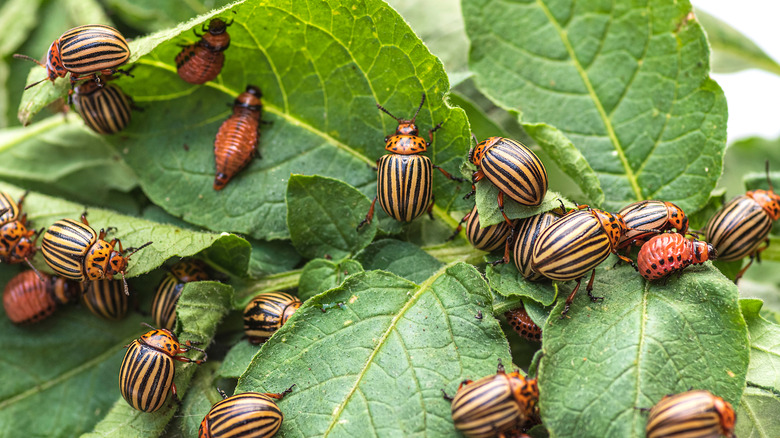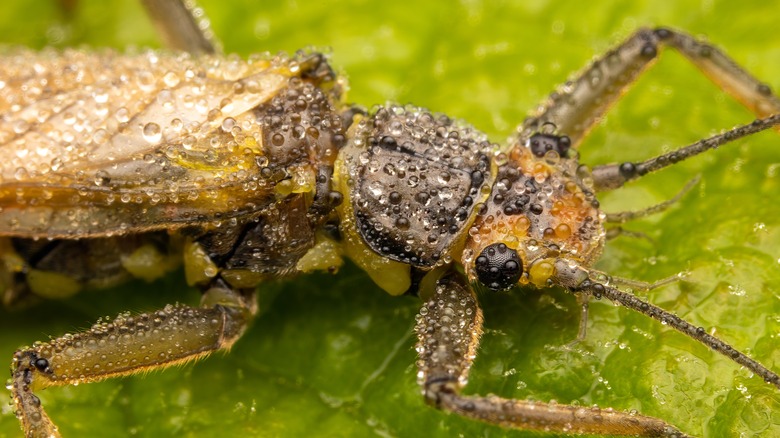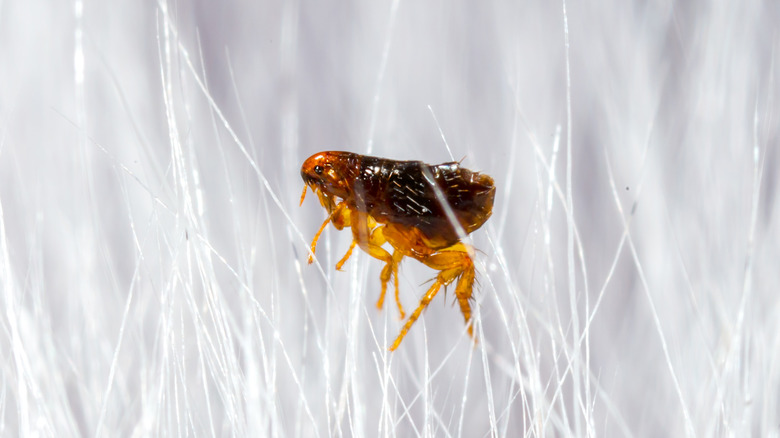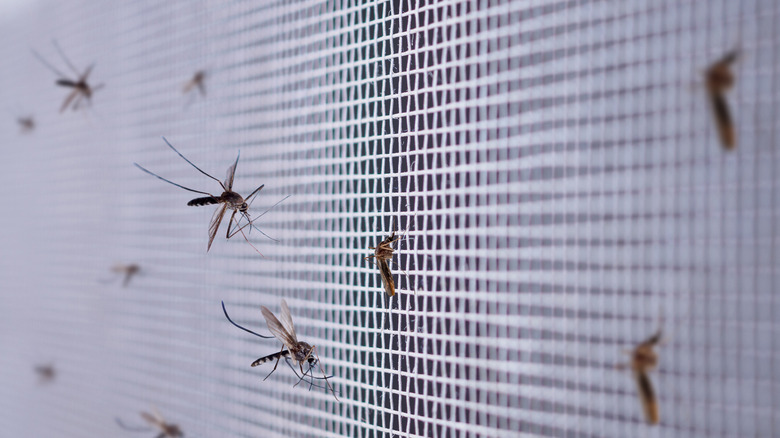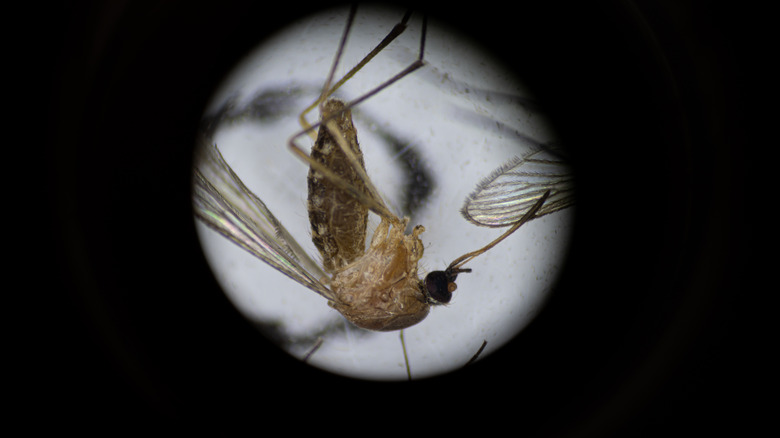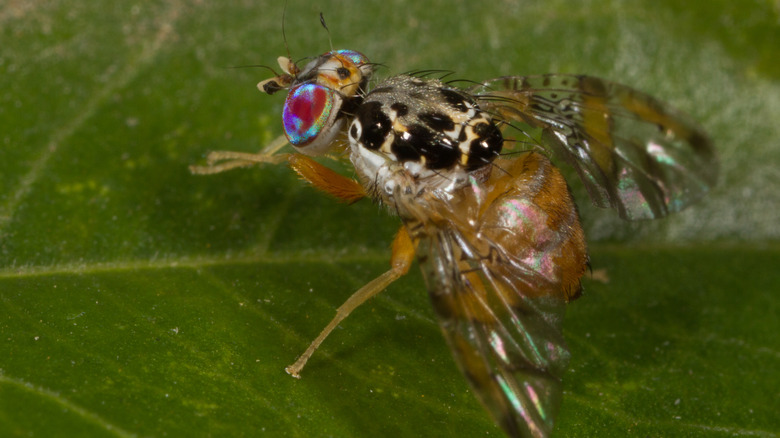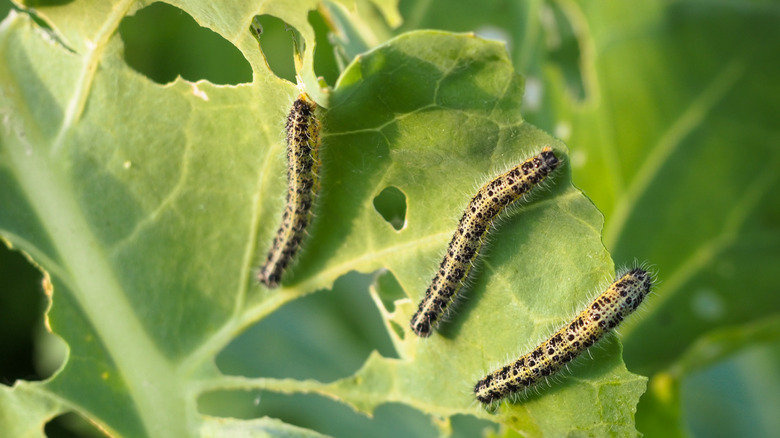The Untold History Of Insect Warfare
The term "biological warfare" typically conjures up images of viruses, bacteria, and HAZMAT suits. But biological warfare can also refer to the use of insects as a weapon, although sometimes, that weapon can also incorporate diseases as well. In general, the use of insects in war has largely been experimented on rather than actually being implemented. But on more than one occasion, insects have found themselves participating in battles in which they have absolutely no stake.
Logistically, using insects in war poses more problems than clear-cut victories. Insects are hard to keep track of and as several experiments would go on to show, once insects are released into the world it can be incredibly difficult to collect them all back. As a result, insect warfare can affect the ecosystem in previously unknown ways, which makes the risk of using them far greater than any potential reward.
And yet, scientists and governments continue to experiment with insects and their potential as fighting combatants. And some of the experiments done by the U.S. military even remain largely classified to this day, so it's difficult to know exactly the full ecological effect of all their entomological tests. At the end of the day, although it's not comparable to a biblical plague of locusts, the use of insects in war can be equally devastating. This is the untold history of insect warfare.
What is insect warfare?
The use of insects in war, also known as entomological warfare, towards the destruction of crops or as a vector for disease has a relatively recent history. But simply using insects as a weapon dates back thousands of years. As early as 198 AD, scorpion-stuffed pots were used during the Second Parthian War to defend Hatra from the Romans, according to Entomology Today. And during the Third Mithridatic War, "grayanotoxin-laden honey created by rhododendron-foraging honeybees" was left out for Roman soldiers, which gave them "intense sickness and hallucinations."
One of the earliest accusations of the use of insects towards crop destruction occurred during the Civil War, when the Confederacy accused the Union of introducing the harlequin bug into the region to destroy Southern crops. However, according to the University of Nebraska, there's little evidence to back up this allegation and it's now believed that the harlequin bug "moved on its own into the South from Mexico."
In "The Evolution of Biological Disarmament," Nicholas Roger Alan Sims writes that although insects aren't specifically mentioned in the Biological and Toxic Weapons Convention (BTWC), their use as a vector for biological warfare is prohibited through the language of Article I. However, when it comes to the use of insects towards the destruction of crops, "it is questionable whether they fall within its scope," despite the fact that intentionally starving a population is considered a war crime.
It's raining plague fleas
As the Black Death spread during the 14th and 15th centuries, the bubonic plague was also used as a weapon, though because it was unknown at the time that fleas were the vector for the bubonic plague, the disease was transmitted using another host instead. Both the cities of Kaffa, Crimea and Karlštejn, Czech Republic witnessed infected human cadavers catapulted over the walls during sieges. And according to Army Chemical Review, it's believed that the refugees who fled Kaffa in 1348 "may have initiated the second plague pandemic that seeded throughout Europe."
As the flea was recognized as a vector of plague by 1911, Japan started experimenting with plague-infected fleas during the Second World War. There were several facilities where Japan conducted biological warfare experiments, but Unit 731 is considered the most notorious.
After developing a bomb filled with plague-infected fleas, Japan tested it by dropping it in Ningbo and Changde in China. But NPR writes that these tests were just a precursor for what was known as Operation Cherry Blossoms at Night, which entailed dropping plague-infected fleas into California. However, the plan was narrowly avoided only because Japan surrendered on September 2, 1945, and Operation Cherry Blossoms at Night had been scheduled for September 22. Had World War II continued for just a few weeks more, there would've likely been a plague outbreak in California.
The Colorado potato beetle and WWII
Plague-infected fleas weren't the only insects at the center of attention during the Second World War. According to The Colorado Potato Beetle Goes to War, Germany feared that the Allied powers were going to use the Colorado potato beetle against German crops and in response, put together their own research program. But although Adolf Hitler only allowed for research into the beetles as a defensive measure, the research was quickly turned towards the offensive.
After a large-scale breeding effort in 1943, field trials were held in Speyer, Germany, and upwards of 40,000 beetles were released over the fields near the city. Although the beetles were reportedly painted so that they could be recovered, "less than 100 beetles were recovered." During another trial, 14,000 beetles were released and only 57 were recovered.
Germany's fears weren't far off. In 1942, the United States sent 15,000 beetles to Britain to be studied as a biological weapon, according to the Journal of Bioterrorism & Biodefense. And in 1939, France was reportedly researching the intensive breeding of the beetles and conducting release trials at Cazaux, per the Chemical and Biological Arms Control Institute. But ultimately, there's little evidence to suggest that the beetles actually found their way into the battles of World War II. And although the East German government accused the United States of dropping beetles all over the country in 1950, it's more than likely that the beetles were in fact German to begin with.
A disinformation campaign?
During the Korean War, the United States was accused of engaging in insect warfare in North Korea. According to Montana State University, Chinese entomologists claimed that the U.S. military was spreading "disease-carrying anthomyiid flies, springtails, and stoneflies with P-51 fighters." There were also accusations that the United States spread plague-infected rats and anthrax-infected flies and spiders.
The Cold War International History Project writes that the Chinese and North Korean governments set up two "international commissions" in order to investigate these claims. While the commission found that the United States "probably did engage in limited biological warfare," the United States insisted that the commission was just a communist front and a disinformation campaign.
But although the United States continues to maintain that insect warfare was never used in North Korea, in 2019, the House of Representatives voted to look into whether or not these claims were truly disinformation or not. Roll Call reports that New Jersey Republican Christopher H. Smith's amendment to the 2020 Defense Authorization Bill would've required the Pentagon inspector general to conduct a review of whether or not the U.S. military had experimented "with ticks and other insects regarding use as a biological weapon between the years of 1950 and 1975." Unfortunately, it didn't pass the Senate, and the Senate has repeatedly refused to pass the provision in subsequent defense authorization bills.
Airdropping fleas in Utah
In September 1954, the U.S. military ran field tests in Utah to determine whether or not fleas could be transported and dropped from the air in bombs, known as Operation Big Itch. The field tests were held at Dugway Proving Ground and guinea pigs were used as the test subject to determine whether or not the trials were a success. Tropical rat fleas were used and, according to Army Chemical Review, for the purpose of the test they were uninfected. This was especially lucky considering that during one of the first attempts, the fleas escaped while on board the plane and bit the "pilot, copilot, and a military observer," Lisa T. Sarasohn writes in "Getting Under Our Skin."
E-14 and E-23 munitions were fitted with an internal actuator to release the fleas from inside and it was found that "both weapons functioned at 1,000 to 2,000 feet above ground level after release from the cluster bomb." In order to keep the fleas alive and allow access to air and moisture, the E-14 and E-23 munitions were filled with sponge fragments and paperboard tubes. And just one E-14 could contain up to 240,000 fleas.
Ultimately, the recommendation after the success of Operation Big Itch was that "continued research of Biological Warfare with arthropod vectors apparently is justified," according to the unclassified files regarding Operation Big Itch. But since fleas were considered difficult to control, the United States turned their insect warfare research onto mosquitos.
It only takes a bite
In 1955, the U.S. military moved on to experimenting with mosquitos in Operation Big Buzz. According to "Six-Legged Soldiers" by Jeffrey A. Lockwood, Operation Big Buzz was a "simulated, mosquito-based attack," in which hundreds of thousands of mosquitos were dropped into rural Georgia. Up to one million Aedes aegypti mosquitoes were raised and in May 1955, a third of the mosquitos were dropped onto rural Georgia in E-14 munitions. The rest of the mosquitos were used in "loading and storage tests." And while the military hoped to see the efficacy of spreading yellow fever through mosquitos, the mosquitos were uninfected for the test.
Guinea pigs were used to determine the success of the test, as were human volunteers. And after the mosquitos managed to find hosts "nearly a half-mile downwind," the experiments were considered to be "a rip-roaring success."
According to a March 1981 Army report, the military estimated that it would cost roughly $27,000 ($131,900 today) to launch a yellow-fever infected mosquito attack on a battalion and approximately 225,000 infected mosquitoes would be required. And this was seen as being more cost-effective than an aerosol attack. Cost analyses were also run to see how much a yellow fever-infected mosquito attack on a city would cost. And achieving a 50% mortality rate, the most cost effective one, would only cost 29 cents per death ($1.42 today).
Mosquitos off the coast
During the Vietnam War, the United States military continued to experiment with mosquitos, and it decided to test out different environments in which mosquitoes could be released. Operation Magic Sword, conducted in 1965, was meant to determine whether or not yellow fever-infected mosquitoes could be successfully released from a ship anchored by the shore. In "Six-Legged Soldiers," Lockwood writes that the experiment was held off the coast of the southeastern United States, which was considered to be the "best approximation" for the coast of Vietnam.
Operation Magic Sword revealed that the mosquitos could travel up to 3.5 miles when assisted by sea breezes. And according to "Isles of Amnesia" by Mark J. Rauzon, although mosquitos typically experience a "rapid decline in flight capacity with age," it was found that the mosquitos could be kept viable for up to 52 days.
The mosquitos used for Operation Magic Sword were uninfected, but the U.S. considered using yellow fever infections as well as Venezuelan equine encephalitis (VEE). And although the U.S. insists that VEE was never tested in the Pacific, the United States did produce "2,500 gallons of VEE and 3,000 gallons of Q fever" in case of another Bay of Pigs invasion. And despite the promise that the militarized mosquitos showed, there's no evidence that the U.S. military ever ended up actually using infected mosquitos in Vietnam.
Invasion of the medflies
Mediterranean fruit flies, also known as Medflies, were first sighted in California in 1975 and by the 1980s, there were multiple eradication programs aimed at the medfly. Between 1975 and 1993, California spent over $170 million on medfly eradication efforts. SFGate writes that the medfly caused "millions of dollars in damage" to various crops and in response, Governor Jerry Brown decided to spray Malathion from helicopters to suppress the medflies.
The infestation of 1989 was notably different from the previous medfly outbreaks. The U.S. Department of Agriculture noted that there were more female medflies than male medflies and there was an absence of the number of larvae one would expect from the number of adults. Plus, "farmers kept finding medflies right outside spray zones."
In December 1989, California state senators, newspapers, and the mayor of Los Angeles received a letter from a group that called themselves The Breeders, taking responsibility for the medfly outbreak. The letter claimed that the group was releasing medflies in order to halt the spraying of Malathion and "Every time the copters go up to spray, we'll go into virgin territory or old Medfly problem areas and release a minimum of several thousand blue-eyed Medflies. We are organized, patient, and determined." Although the USDA tried to make contact with The Breeders, they reportedly got no response. And at the end of the day, Malathion spray stopped being used, and instead, the state started "introducing sterile flies into the population."
Caterpillars and the War on Drugs
By the end of the 20th century, the United States took its War on Drugs to another level as it tried to recruit insects as combatants. The New York Times reports that in 1990, the Bush Administration proposed quadrupling the budget of the Agricultural Research Service so that they could study the cocaine tussock moth, also known as "Eloria-noyesi, a coca-eating caterpillar, and the feasibility of dropping millions of the insects into the coca fields of Peru and Bolivia."
Although a White House spokesman insisted that the United States wasn't "undertaking any biological war," both Peruvian and Bolivian officials were less than thrilled with the proposed course of action. According to the Washington Post, a Bolivian official said that since the use of chemicals had been rejected due to environmental concerns, it was unlikely that Bolivia would approve the use of a biological agent to destroy coca crops.
There's no evidence that the United States followed through on their plan to drop caterpillars onto coca fields, but the idea has been picked up by other countries as well. According to Smithsonian Magazine, the Colombian government has also looked into raising the cocaine tussock moth, but there's been a backlash against this proposal as well. Not only could dropping huge populations of moths into the area "throw the local ecosystem out of whack," but there's no guarantee that the caterpillars could discriminate between the coca that's processed into cocaine and the legal coca crops.
CRISPR insects
As gene-editing is being used to make plants more resistant to disease, the U.S. Defense Advanced Research Project Agency (DARPA) has been looking into using insects as a vector for gene-editing. According to Wired, as part of a program called Insect Allies, DARPA is researching how to use insects to deliver the viruses needed to genetically edit crops in the field.
However, many biologists and ethicists argue that "this new technology poses a biosafety risk and could easily be turned into a new kind of biological weapon." And there are also functional issues with this, since gene-editing through an insect is undoubtedly going to be imprecise and it'd be almost impossible to guarantee that all the plants were being edited in the same way. And unfortunately, no matter how promising research can look, "it's always easier to make it a weapon," notes Guy Reeves, a biologist at the Max Planck Institute for Evolutionary Biology.
According to Entomological "Weapons" of Mass Destruction by Thomas F. Moore, scientists are also experimenting with editing the genomes of mosquitos, ultimately towards incapacitating the mosquitos to prevent the spread of disease. In doing so, scientists created "a yellow, three-eyed, wingless version." And although scientists see this as the potential towards eradicating the spread of disease by mosquito, this research also "reveals how the genetic code might also be corrupted to do harm in living organisms."
